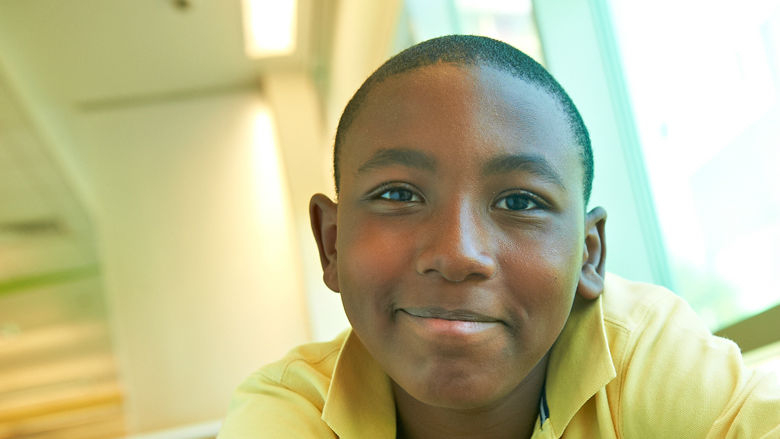Lymphatic Leaks: Marta's Story
Marta was a happy, healthy teen. At 15, she'd just moved from Latvia to Norway with her family. She was enjoying learning about her new country and meeting new friends.
But a seemingly minor fall at school changed all that.
From that day on, she became easily winded and felt tired and sick all the time. Doctors initially suspected trauma to her lungs or asthma, but they couldn’t find anything wrong.
As time went on, her symptoms worsened.
“I was short of breath more often,” says Marta. “I couldn’t lie down to sleep; it put too much pressure on my lungs and heart. I felt like I was drowning in my own body and there was nothing I could do.”
Finally in 2014 — four years after the initial symptoms began — doctors in Norway discovered the problem: her lymphatic system was leaking an exceedingly large amount of fluid into her chest and abdomen.
Normally, lymph fluid is supposed to be absorbed from tissue and transferred back into the venous system. But Marta had a rare condition, called chylothorax, in which lymph fluid leaks into the chest. If left untreated, the disorder could be fatal.
Unfortunately, Norwegian doctors had no idea how to fix it.
Searching for answers
Desperate for answers, Marta’s mother, Vairite Zvingule, contacted doctors throughout Norway and Latvia and scoured the internet to find treatment options for children with rare lymphatic disorders.
She happened upon the story of Davis Janus, a 9-year-old Latvian boy whose symptoms were similar to Marta’s. He was cured by a special lymphatic procedure, a treatment developed at CHOP and offered by CHOP’s Center for Lymphatic Imaging and Interventions.
Vairite told Marta’s doctors about Davis’ story. Quickly, they contacted Maxim Itkin, MD, and Yoav Dori, MD, PhD, the pioneering doctors and directors of the Center for Lymphatic Imaging and Interventions at Children’s Hospital of Philadelphia, and shared details about Marta’s condition.
After reviewing Marta’s records and meeting Marta and her mom via Skype, the CHOP doctors said they would help. While her condition was rare, they had treated many other children with lymphatic leaks and developed advanced tools to locate and repair the leaking vessels. They believed they could cure her condition.
That’s when CHOP’s Global Patient Services (GPS) team got involved. Jaime Powers, BSN, RN, CCRN, clinical nurse coordinator for GPS, worked with Marta’s doctors, her family and the Norwegian Health Services to get financial clearance, and resources for travel and housing in Philadelphia. GPS, which is a service of CHOP's Department of Global Medicine, also provides medically trained interpreters to patient families.
After a few weeks of arrangements, Marta was finally approved to come to Philadelphia for treatment. On March 25, she and her older cousin, Zane, arrived in Philadelphia and immediately came to CHOP.
Treatment at CHOP
Once Marta was admitted to CHOP, the Lymphatic team used dynamic contrast MR lymphangiography (DCMRL) to map the anatomy and flow of her lymph system and locate leaking vessels. This imaging test was developed by CHOP’s Center for Lymphatic Imaging and Interventions, and provides a more detailed view of the lymphatic system than conventional lymphangiography. It is used to plan the lymphatic interventional procedure.
Dr. Itkin and Dr. Dori then perform selective lymphatic embolization, a procedure that seals the leaking ducts. DCMRL allows doctors to target lymphatic ducts causing the leaks, while leaving the rest of the lymph system intact.
After four of these procedures, Marta’s doctors felt confident they had repaired all of the leaks in her lymphatic system. They removed the ports in her back and chest that had been used to drain fluid. Finally, she could lie down comfortably without feeling pressure on her chest and medical devices sticking out of her.
On April 28, Marta was discharged from the Hospital. For the next week, she and Zane stayed at a hotel in Philadelphia while she regained her strength. When Marta had her follow-up visit with her CHOP doctors, a chest X-ray confirmed what Marta could feel — the interventions worked. She no longer had fluid in her chest. She was approved to return home to Norway.
Back home
Marta returned home in early May. She plans to spend the coming months regaining her strength, reconnecting with friends, and experiencing all she has missed because of her condition.
In the fall, she’s headed to university. Marta, who speaks six languages, hopes to become both a lawyer and an interpreter.
Today, Marta no longer needs medication, ports or medical support to survive. She does take vitamins daily, and is followed closely by her doctors, but these are minor inconveniences compared to the challenges of the past five years.
“My lymphatic condition was the only thing in the way of me having a normal life — and now, thanks to Dr. Itkin and Dr. Dori — it’s fixed,” Marta says. “They are like magicians. I was so sick and they made my illness disappear.

